Becoming a globally recognized yoga instructor involves more than just teaching yoga; it requires building a strong personal brand, gaining significant experience, and leveraging various platforms to reach a worldwide audience. Here’s a detailed roadmap to help you achieve global recognition in the yoga community:
Master Your Yoga Skills:
Mastering your craft as a yoga instructor involves deepening your practice, understanding the nuances of yoga philosophy and anatomy, and continually expanding your skills. Here are some example practices to master your skills:
Dedicate time to mastering both foundational and advanced poses. Focus on alignment, balance, strength, and flexibility. Practice various breathing techniques like Nadi Shodhana (alternate nostril breathing), Kapalabhati (skull-shining breath), and Bhastrika (bellows breath). Establish a regular meditation practice to enhance mental clarity and emotional stability. Regularly study yoga philosophy and reflect on how it applies to your practice and teaching.
Set clear intentions for your practice. Focus on what you want to achieve, whether it’s mastering a particular pose, improving flexibility, or deepening meditation. Establish short-term goals for your practice, such as learning new poses, increasing stamina, or refining techniques. Set long-term goals like completing advanced training, learning specialized yoga styles, or enhancing teaching skills.
Commit to a consistent and evolving personal yoga practice to deepen your understanding and mastery of yoga. Pursue advanced certifications and specializations (e.g., 500-hour Yoga Teacher Training, Iyengar certification, Yoga Therapy).
Solidify Your Foundation:
Solidifying your yoga foundation involves deepening your knowledge, refining your skills, and building a supportive community. Some of the factors in solidifying your yoga foundation are:
Study Yoga Philosophy and Classical Texts such as the Yoga Sutras of Patanjali, the Bhagavad Gita, and the Hatha Yoga Pradipika, Read contemporary books and articles, Learn Anatomy and Physiology, Courses and Workshops,Practical Application, Basic Certification, Obtain Reputable Certifications, 200 Hour Yoga Teacher Training in Rishikesh, Specializations in additional certifications in specific styles (e.g., Ashtanga, Iyengar), Develop Strong Teaching Skills, Practical Teaching Experience, Regular Classes, Private Teaching Sessions, Seek Students Feedback, Build a Supportive Community, Network with Other Instructors, Working in Local Community, Online Communities, Invest in Continuous Learning, Workshops and Seminars, Special Topics
Obtain Reputable Certifications:
Obtaining a reputable yoga certification is a crucial step in becoming a respected and successful yoga instructor. Ensure your training programs are certified by the Yoga Alliance or other reputable organizations. Register as an RYT (Registered Yoga Teacher) at both the 200-hour and 500-hour levels.
200-Hour RYT (Registered Yoga Teacher): This foundational certification is widely recognized and covers essential aspects of yoga teaching, including asanas, anatomy, philosophy, and teaching methodology. 300-Hour RYT: For those who have completed the 200-hour training, this advanced certification deepens your knowledge and teaching skills. 500-Hour RYT: Combines the 200-hour and 300-hour training for a comprehensive and advanced certification. Yoga Alliance also offers certifications for specialties such as prenatal yoga, children’s yoga, and yoga therapy. There are several locations in the world for this training including 200-hour Yoga TTC in Rishikesh.
Build a Diverse Teaching Portfolio:
Offer a variety of classes (e.g., Vinyasa, Hatha, Yin, Restorative) to different audiences, from beginners to advanced practitioners. Conduct workshops and retreats to provide immersive experiences and attract dedicated students.Offer personalized one-on-one sessions to cater to individual needs and build a loyal client base.
Create a Strong Online Presence:
Develop a professional website featuring your bio, teaching philosophy, class schedules, and contact information. Utilize platforms like Instagram, Facebook, and YouTube to share yoga content, engage with followers, and promote your offerings. Post regularly with high-quality content, including tutorials, inspirational quotes, and personal stories. Write blogs or create vlogs about yoga techniques, philosophy, lifestyle tips, and your personal journey.








